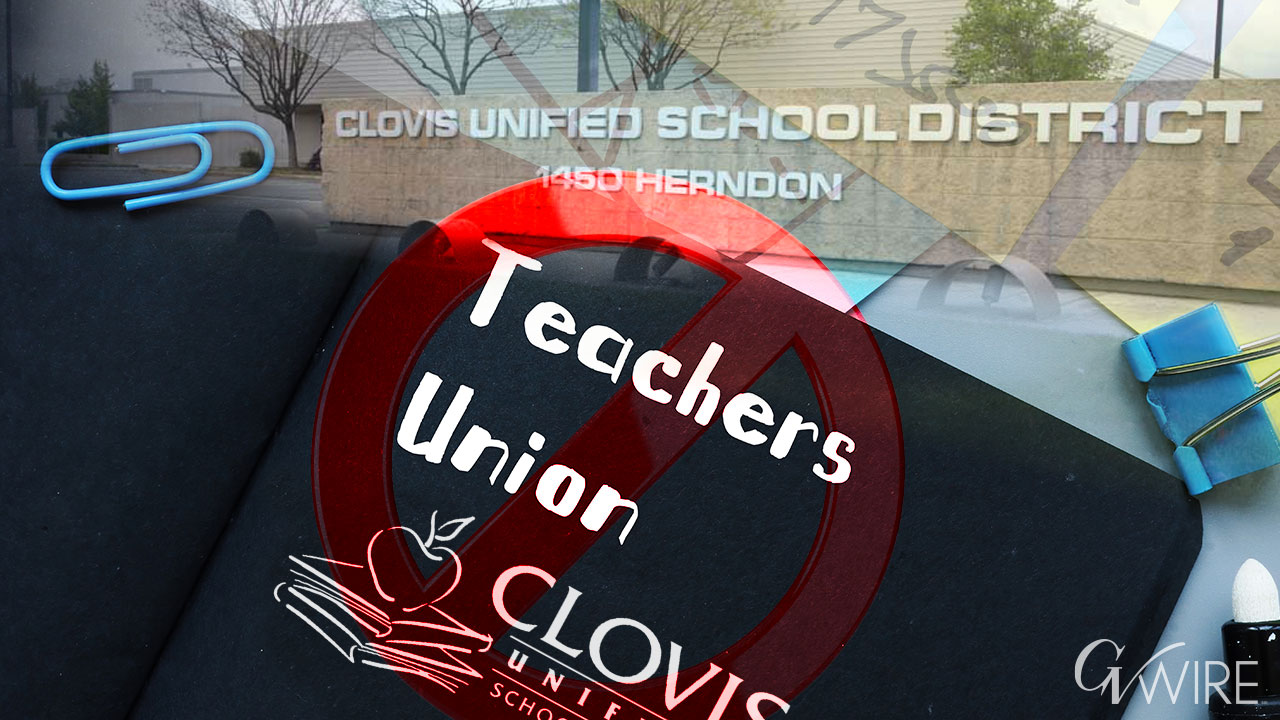Teachers in Clovis Unified School District are within reach of becoming unionized — the closest they’ve been in decades — and they have a choice of two suitors. (GV Wire Composite)

- One of two groups trying to unionize teachers in Clovis Unified is less than 75 signatures away from accomplishing that goal.
- The elimination of the district’s non-union teachers group, which had operated for decades, paved the way for unionization.
- Clovis Unified is California’s largest school district without a teachers union, but could become the state’s largest independent union.
Share
|
Getting your Trinity Audio player ready...
|
Teachers in the Clovis Unified School District are within reach of becoming unionized — the closest they’ve been in decades. Now, they have a choice of two suitors.

Lasherica Thornton
EdSource
Despite many attempts, the district is California’s largest school system without a teachers union.
A key difference this time: Last year, the state labor board disbanded the Faculty Senate, a district-supported non-union group that represented teachers, leaving them with no collective voice speaking on their behalf and pushing them to choose a legally recognized union out of “a matter of necessity,” teachers told EdSource.
Over the last four years, two groups — the Association of Clovis Educators (ACE), backed by the California Teachers Association, and the unaffiliated Independent Clovis Unified Educators (ICUE), represented by a law firm — have been vying to represent district teachers.
“Teachers are realizing, ‘It’s ACE or ICUE,’” said Erin Dieterle Garcia, a founding teacher of ICUE, which is less than 75 signatures away from becoming the group to represent and bargain on behalf of educators.
Teachers champion ICUE, the independent group that promises cheaper dues and local control, because they don’t have ties to the California Teachers Association (CTA), which represents most teachers unions across the state. But educators also base their support on personal experiences and group reputation.
There are still many teachers on the fence, often remaining quiet about their indecision. Perhaps they are hoping for an election.
The ACE or ICUE must gather the signatures of more than 50% of approximately 2,100 teachers within a year.
To become the recognized union:
- Whichever group collects the majority of signatures first must file a petition to be certified as the union.
- If the other group has 30% of signatures, that group can request an intervention to the existing petition, which will force a vote between the two unions or for no union representation.
- If the other group doesn’t file that petition for intervention, there is automatic union recognition and no election.
ACE does not have updated percentages considering new teacher hires, but had gathered over 35% last year. Based on the number ICUE provided to EdSource, they’ve reached around 47% of signatures.
And if enough teachers sign on to ICUE, the group will be closely watched as the largest independently run teachers union in California.
Why Unionization Hasn’t Happened
The Faculty Senate, before its ordered disbandment, was much like an advisory panel, representing teachers by communicating on their behalf, but unlike a union, it could not bargain or negotiate for employee benefits such as pay.
Many Clovis Unified teachers had been satisfied with the Faculty Senate’s representation, Garcia said.
In a 1984 decision, California’s Public Employment Relations Board ruled that the district favored the Faculty Senate over the Clovis Unified Teachers Association, a CTA-backed group that was trying to unionize at the time. For 40 years, Clovis Unified had continued to violate state neutrality rules by providing unlawful support to the Faculty Senate and deterring employees from joining ACE or other groups, PERB found in 2024.
PERB required Clovis Unified to not only disestablish the Faculty Senate, but also to publicly read and post a notice of the district’s violations and the group’s disbandment in an attempt to overcome the decades-long advantages the group had — seemingly paving the way to unionization.
Many teachers, over the years, had been waiting for the outcome of the PERB rulings to pick a side.
But some teachers have not wanted to unionize. Being a non-union district has attracted several teacher candidates over the years, district officials have said.
Others argue that teachers have not unionized in the district’s 65-year history because of an alleged anti-union culture.
The district’s reported antipathy to unions is often attributed to its unlawful support of the Faculty Senate and to Floyd “Doc” Buchanan, the district’s founding superintendent, who served until 1991.
High school physics teacher Christopher Kipp, who has worked in Clovis Unified for the past decade, said he’s often heard stories about the late 1970s when Buchanan’s speeches allegedly threatened teachers about unionizing, according to a case brought before PERB.
Even now, high school English teacher Laramie Woolsey said there seems to be a disconnect between — and even distrust among — district administration, groups trying to unionize, and educators.
“It seems like a fear of the unknown,” Woolsey said. “I think a lot of people don’t really understand how unions work or what purpose they serve.”
The two groups, organizers say, have been trying to educate employees about the benefits of having employee representation and bargaining power.
Personal Experiences, Group Reputation Driving Union Support
One group offers resources to improve Clovis Unified working conditions and give the district a seat at the table on statewide issues. The other group offers to do things the “Clovis way,” developed as an alternative to traditional union models.
As a new teacher, Woolsey’s experience with unions has been in getting guidance and support. For example, last year, she said she was disciplined for displaying a sign that welcomed all students, including those in the LGBTQ+ community.
The CTA-affiliated ACE helped Woolsey by ensuring she was aware of potential disciplinary action and how to navigate the process. That’s why she signed with ACE, which she said is working to ensure educators have protection.
ACE, formed in 2020, has wanted to provide a “meaningful voice” in the district’s decision-making process. Many teachers said they felt excluded from decision-making during the coronavirus pandemic.
Kipp, the high school physics teacher, joined the ACE movement for that reason. “I have been very vocal in criticizing the decisions of the admin since that point,” he said.
While trying to garner support among teachers over the years, ACE has formed unions with Clovis Unified mental health professionals and with American Sign Language interpreters. Since unionizing, ACE has negotiated higher pay, better staffing ratios and workloads and guaranteed leave time for its mental health staff.
A
And Clovis Unified teachers would gain the opportunity to shape how legislation affects educators statewide with the political influence of the CTA, said Roxanne Garrigus-Case, the former president of the teachers union in the Selma Unified School District and a state council representative for the CTA.
“When we have a big group like Clovis that’s not involved, their voice doesn’t get heard,” she said.
But the founding teachers of the ICUE didn’t want involvement with state or national organizations, said Tony Silva, the labor representative for the law firm Goyette, Ruano & Thompson, which represents ICUE.
“We’re not going to be worried about some other cause outside of Clovis Unified,” he said about what he and ICUE members pitch to other teachers.
Dues for representation by ICUE will also be less expensive because the group has only local ties.
Under the CTA model, dues would be allocated to ACE as the local entity, CTA as the state association, and the National Education Association as the national organization for services at different levels. Educators can opt out of payments to support political efforts. Under the ICUE model, dues are budgeted to be $39 a month, much less than the combined dues for ACE, CTA and NEA, but for better service, said Tony Silva, the labor representative for the law firm that represents ICUE. “None of your money is going to be going to groups that have nothing to do with Clovis Unified,” he said.
ICUE organizers said teachers are more comfortable with that model. “We didn’t really like the option of having the CTA in our district, so we had to make our own thing, which is a very Clovis thing to do,” Garcia said. “We’ll do things to suit our own needs.”
And ICUE’s approach to working with district leadership is based on relationships, not on being at odds with administration, she said.
Jill Drilling, a middle school history and language arts teacher, agrees.
“The way that we work with our admin, the way that we try to remedy it, is what I believe in,” Drilling said about ICUE. “I believe in working together.”
Far-Reaching Impact If Teachers Choose an Independent Union
Attorney Rafael Ruano, a partner with the firm behind ICUE, estimates that there are about a dozen independent teachers unions across California, a number that could be much larger, with independent groups often representing small charter schools.
If Clovis Unified teachers choose ICUE, the independent union would be the largest in the state.
“If Clovis teachers are represented in an independent model,” Ruano said, “and that model works — those teachers are paying dues that are less than half of what most other teachers are in the state, and they’re getting good representation, and their contracts are good — I think that creates a potential for other teachers in other districts to say, ‘Let’s look into that.’ ”
About the Author
Lasherica Thornton covers education in California’s Central Valley. Follow her on X @LashericaT
RELATED TOPICS:
Categories

US, Iran Spar Over Nuclear Talks at UN

















